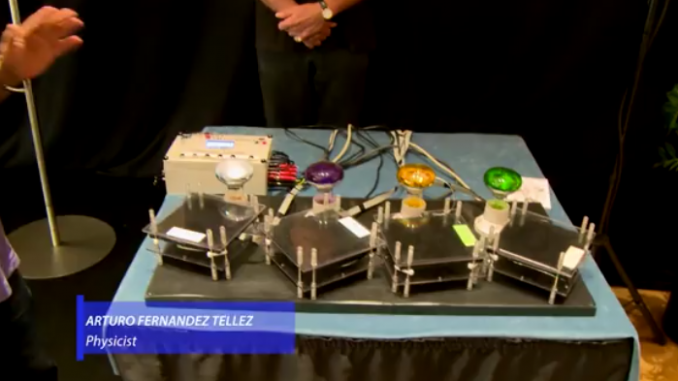
This past July, jazz pianist Al Blatter had a new musical partner at Switzerland’s Montreux Jazz Festival: the aptly named “cosmic piano,” a musical instrument designed by the scientists at CERN. The cosmic piano uses comic ray data to make music.
From Gizmodo.com:

BYPASS THE CENSORS
Sign up to get unfiltered news delivered straight to your inbox.
You can unsubscribe any time. By subscribing you agree to our Terms of Use
Latest Video
Whenever a particle passes through a detector pad on the instrument, the result is a musical note and a flash of light.
It’s the latest creative use by particle physicists (among others) of sonification, the process by which raw data is converted into sound. In the past, music has been generated using data from the rings of Saturn, the Northern lights, the solar wind, the cosmic microwave background radiation, infrasonic “voices” of volcanoes, and black holes, to cite just a few. A few years ago, British composer Alexis Kirke created a duet between a live violinist and the radioactive subatomic particles produced inside a cloud chamber. NASA’s latest endeavor is a streaming Internet radio broadcast — where you can listen to the live sonification of raw data — called CRaTER (Cosmic Ray Telescope for the Effects of Radiation), constantly converting data from its Lunar Reconnaissance Orbiter into music.
Last year, to mark its 60th anniversary, CERN showcased the LHCChamber Music project, in which scientists — playing harp, guitar, two violins, a keyboard, a clarinet, and a flute — performed a composition by Domenico Vicinanza, based on data from the four major experiments at the Large Hadron Collider. (Vicinanza previously composed a piece drawn from the data that helped physicists discover the Higgs boson, as well as magnetometer readings from the Voyager mission.).
CERN’s cosmic piano is the brainchild of physicist Arturo Fernandez and his collaborator Guillermo Tejeda, using components from the ALICE experiment to build it. According to Physics World, the instrument looks “a bit like a fancy staircase” and sounds like R2-D2. And it’s proved so popular that several such instruments have been sold since it debuted at a CERN open house in 2013. (Retail price: around $2500.)
So how did the Montreux festival performance go? As freewheeling polyrhythmic jam sessions go, pretty well, despite the challenges the musicians faced trying to match the sonic outpourings of random cosmic rays. As CERN physicist Steven Goldfarb puts it in the video below, “The cosmos doesn’t really have much of a rhythm.”


